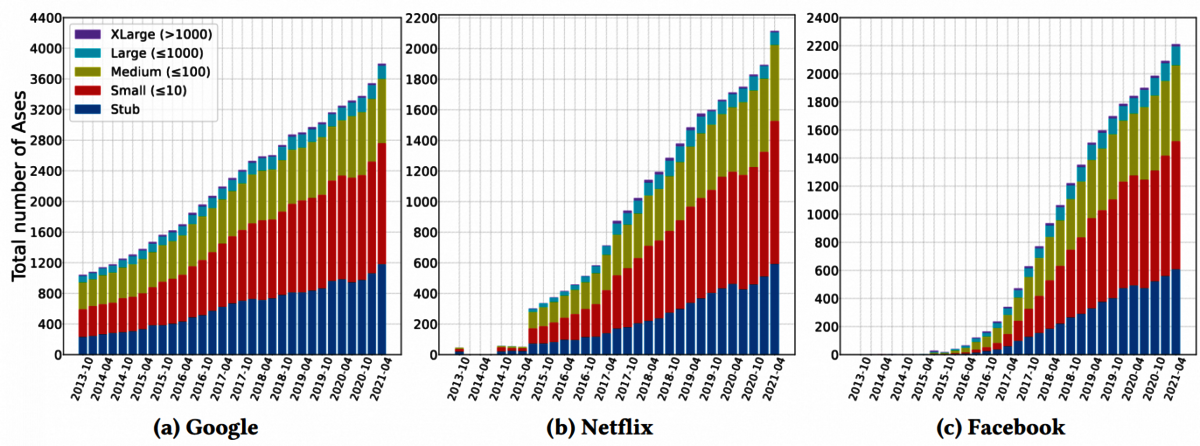BIFOLD Fellow Prof. Dr. Georgios Smaragdakis and his colleagues received the prestigious ACM SIGCOMM 2021 Best Paper Award for their research into the expansion of Hypergiant’s off-nets. They developed a methodology to measure how a few extremely large internet content providers deploy more and more servers in end-user networks over the last years. Their findings indicate changes in the structure of the internet, potentially impacting network end-user experience and neutrality regulations.


An increasing amount of the digital content delivered to Internet users originates from a few very large providers, like Google, Facebook or Netflix, the so-called Hypergiants (HGs). In 2007 thousands of autonomous networks (AS) – e.g. networks of an Internet service provider or university – were necessary to provide 50% of all content. In 2019 only five Hypergiants managed to originate half of the total Internet traffic alone. To cope with the unprecedented demand, most of these Hypergiants increased their network capacities in their own networks, but also installed and operated their servers, called off-nets, inside other networks. Such off-nets operate closer to the end user and, thus, accelerate content delivery to end-users as well as support applications, e.g., video streaming and edge computing (machine learning, artificial intelligence, and 5G).
In their paper “Seven years in the life of Hypergiants’ off-nets,” Georgios Smaragdakis, Professor of Cybersecurity at TU Delft, and his colleagues from University College of London, Microsoft, Columbia University and FORTH-ICS present a methodology to measure the increase of such off-nets footprints by analyzing massive public data sets that include active scans and server digital certificates (TLS) that span over seven years (2013-2021). By analyzing the ownership of the certificates over time, they were able to track the deployment of Hypergiants’ off-nets around the globe. These Internet analytics are important to understand how the structure and operation of the Internet and the data flow has changed. For this work the researchers received the prestigious Best Paper Award of the 2021 ACM Special Interest Group on Data Communication (SIGCOMM 2021) conference. SIGCOMM is the flagship conference of the Association of Computing Machinery (ACM) on the topics of internet architecture and networking.

“Internet infrastructures are the backbone of contemporary communication. Understanding developments in this sector is a key prerequisite for improving end-user experience, security, and privacy. We are very pleased that our efforts to monitor and explain changes in the Internet architectures are internationally recognized."
“This is the first generic and scalable method to survey this development in the wild. We make publicly available the only extensive collection of data and visualizations that describe such Hypergiant off-net developments over seven years, from 2013 to 2021”, explains Georgios Smaragdakis. He and his colleagues found that large Hypergiants can serve large fractions of the world’s internet users directly from within the users’ networks. “While the deployment of off-nets can improve end-user performance and the introduction of encryption improve user privacy, our study shows that information about these deployments is leaked and can be potentially misused by adversaries or to gain business intelligence. In our work we suggest ways to address such issues”, says Georgios Smaragdakis. Prof. Smaragdakis and his colleagues believe that the insights by their data analysis and the release of public data can inform studies in other fields, including economics, political science, and regulation.
THE PUBLICATION IN DETAIL:
Petros Gigis, Matt Calder, Lefteris Manassakis, George Nomikos, Vasileios Kotronis, Xenofontas A. Dimitropoulos, Ethan Katz-Bassett, Georgios Smaragdakis: Seven years in the life of Hypergiants’ off-nets. SIGCOMM 2021: 516-533
Content Hypergiants deliver the vast majority of Internet traffic to end users. In recent years, some have invested heavily in deploying services and servers inside end-user networks. With several dozen Hypergiants and thousands of servers deployed inside networks, these off-net (meaning outside the Hypergiant networks) deployments change the structure of the Internet. Previous efforts to study them have relied on proprietary data or specialized per-Hypergiant measurement techniques that neither scale nor generalize, providing a limited view of content delivery on today’s Internet.
In this paper, we develop a generic and easy to implement methodology to measure the expansion of Hypergiants’ off-nets. Our key observation is that Hypergiants increasingly encrypt their traffic to protect their customers’ privacy. Thus, we can analyze publicly available Internet-wide scans of port 443 and retrieve TLS certificates to discover which IP addresses host Hypergiant certificates in order to infer the networks hosting off-nets for the corresponding Hypergiants. Our results show that the number of networks hosting Hypergiant off-nets has tripled from 2013 to 2021, reaching 4.5k networks. The largest Hypergiants dominate these deployments, with almost all of these networks hosting an off-net for at least one — and increasingly two or more — of Google, Netflix, Facebook, or Akamai. These four Hypergiants have off-nets within networks that provide access to a significant fraction of end user population.
Content Hypergiants deliver the vast majority of Internet traffic to end users. In recent years, some have invested heavily in deploying services and servers inside end-user networks. With several dozen Hypergiants and thousands of servers deployed inside networks, these off-net (meaning outside the Hypergiant networks) deployments change the structure of the Internet. Previous efforts to study them have relied on proprietary data or specialized per-Hypergiant measurement techniques that neither scale nor generalize, providing a limited view of content delivery on today’s Internet.
In this paper, we develop a generic and easy to implement methodology to measure the expansion of Hypergiants’ off-nets. Our key observation is that Hypergiants increasingly encrypt their traffic to protect their customers’ privacy. Thus, we can analyze publicly available Internet-wide scans of port 443 and retrieve TLS certificates to discover which IP addresses host Hypergiant certificates in order to infer the networks hosting off-nets for the corresponding Hypergiants. Our results show that the number of networks hosting Hypergiant off-nets has tripled from 2013 to 2021, reaching 4.5k networks. The largest Hypergiants dominate these deployments, with almost all of these networks hosting an off-net for at least one — and increasingly two or more — of Google, Netflix, Facebook, or Akamai. These four Hypergiants have off-nets within networks that provide access to a significant fraction of end user population.


